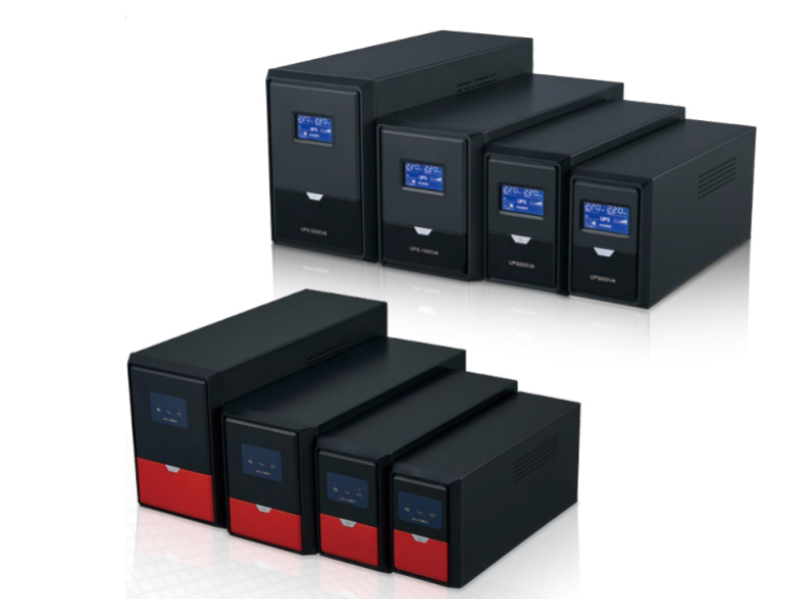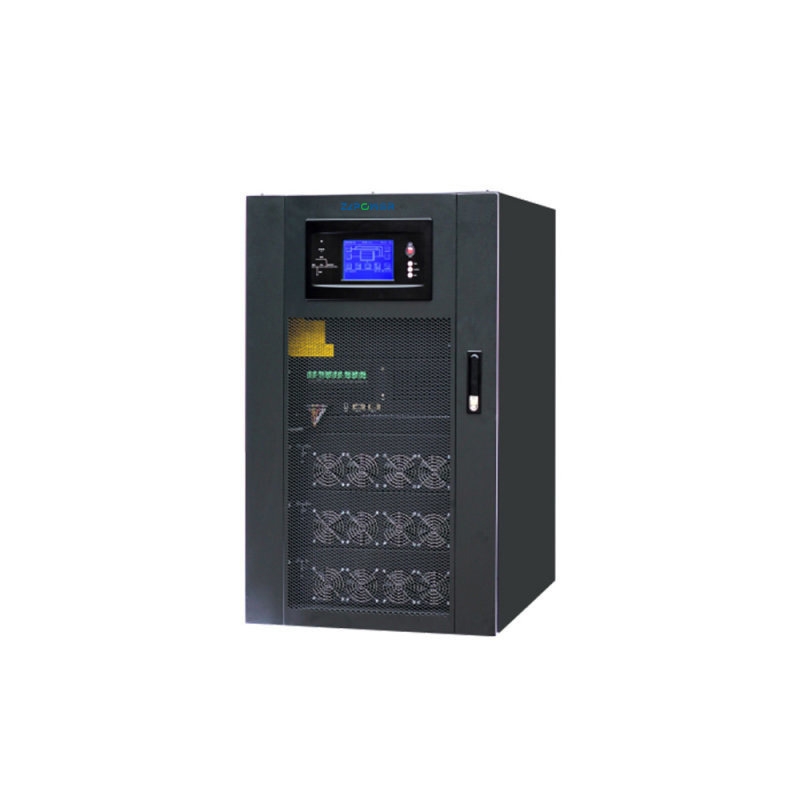

In today‘s technology-based age, the demand for power has increased manifold since businesses and households use electronic devices. This has increased the need for steady backup power. Uninterruptible Power Supply (UPS) systems are crucial in power outages, protecting equipment from voltage issues and allowing time to shut down safely. Online and line interactive UPS models are available. When choosing between them, businesses and individuals assess workload type, budget, and power - protection needs.
Online UPS systems are renowned for their ability to deliver continuous and clean power without interruptions. They are particularly suited for environments where even brief disruptions in power can have severe consequences.
The fundamental technology driving a UPS incorporates dual conversion techniques. This process involves initially transforming incoming AC power into DC using a rectifier, followed by converting it back into AC through an inverter for distribution to connected equipment or devices. This dual conversion process serves to eliminate any inconsistencies in the input power like surges, sags, or frequency fluctuations, before reaching the end users‘ devices.
During a power outage online UPS systems smoothly switch to their battery power without any interruption in operation, unlike other UPS systems that wait for a disruption before using the battery backup mode. They continuously use battery power while keeping them charged at the time. This setup allows for mode switching and provides the highest level of protection, against various electrical issues.
Online UPS systems are perfect for tasks like running data centers and medical equipment or powering industrial operations where maintaining stable voltage and frequency is essential, for precision.
Line interactive UPS systems find a ground between cost-effectiveness and practicality and are commonly employed in small offices and households where moderate safeguard, against power problems is adequate.
The foundation of line UPS technology is centered on an automatic voltage regulator known as AVR, which regulates incoming voltage within safe parameters without needing to switch to battery mode thereby preserving battery longevity and safeguarding against slight fluctuations such, as brownouts or overvoltages.
During normal operation, line interactive UPS units draw power from the main electrical source while simultaneously recharging their internal batteries. In the event of a power disruption or outage, these units swiftly switch to battery-powered mode. This transition ensures connected devices continue to receive uninterrupted power without service interruption
Line interactive UPS units usually take a few milliseconds to switch between using power and battery power modes which is generally fine for most situations but might not be ideal, for really sensitive equipment that needs an immediate switchover.
Line interactive models are widely favored by users looking for cost solutions that still provide essential protection features due, to their efficiency levels; however, they might not match the performance of online UPS systems in handling challenging power quality problems.
In comparing UPS and line interactive UPS systems, it‘s important to grasp their distinct features and uses fully Online UPS. Systems are tailored for settings that demand top-notch power protection. Their double conversion technology guarantees that linked devices get steady and uninterrupted power, making them fitting for critical tasks like data centers health equipment and industrial operations. Online UPS systems ensure smooth switching, during power interruptions.
As they run consistently from their internal battery. This feature prevents delays, in transferring data and safeguards delicate machinery from any power fluctuations.
|
Feature |
Online UPS |
Line-Interactive UPS |
|
Working Principle |
Uses double-conversion (AC→DC→AC) continuously, isolating loads from raw power |
Uses automatic voltage regulation (AVR) + battery backup when needed |
|
Conversion Time |
0 milliseconds (no break) |
2-4 milliseconds (brief interruption during switch to battery) |
|
Efficiency |
90-95% (continuous inverter operation) |
95-98% (inverter only activates during power issues) |
|
Voltage Regulation |
Full voltage & frequency stabilization |
Adjusts voltage via AVR (±8-15% range), no frequency correction |
|
Battery Usage |
Battery only used during power failures |
Battery used for both voltage correction and outages |
Opting for a UPS system is advisable when your business relies heavily on essential equipment that cannot handle any disruptions in power supply. These systems prove useful in sectors such as healthcare, IT infrastructure, and manufacturing where accuracy and dependability are crucial. The dual conversion process of online UPS guarantees that all linked devices are safeguarded against electrical issues like spikes, dips, and fluctuations, in frequency.
In data centers that require servers to operate 24/7 without interruption, online UPS systems ensure immediate power backup with zero downtime during outages or electricity fluctuations.These systems also shield life-saving medical equipment, such as ventilators and diagnostic machines, from abrupt power failures in critical healthcare settings.By maintaining continuous power supply during disruptions, these solutions safeguard essential operations across high-stakes environments.
While online UPS units may cost initially and use more energy because they run continuously their unmatched level of protection is essential for critical applications, with high risks involved.
Line UPS systems work well for small businesses and home offices or for personal use when budget limitations are a key factor to consider. They offer protection against common power problems such, as brownouts or overvoltages and are also energy efficient compared to online models.
The built-in voltage control system in line UPS units is designed to prolong battery lifespan by reducing the frequency of shifts to battery mode. This makes them ideal for locations with generally steady power supplies that still experience occasional fluctuations.
If you need a power source for your home desktop computers or entertainment systems during brief power outages or minor voltage fluctuations, a line-interactive UPS could be a suitable option.This solution meets your needs effectively without costing too much. However, if your setup involves electronics requiring instant switchover features this type of UPS might not be sufficient.

When choosing the online UPS for your requirements it‘s important to consider a range of factors tailored to your individual needs.
1. Make sure to calculate the combined power usage of all the devices you plan to link to the UPS system and pick a model that can support this load along with some capacity, for potential future upgrades.
2. Consider the duration you require power to last in case of an outage and choose a model with a battery capacity that can meet those needs adequately.
3. Assess the importance of your applications by determining if they are essential for your operations or not crucial at all. If you are dealing with sensitive tools like medical instruments or servers focus first on selecting models that come with advanced capabilities, like zero downtime transfer.
4. When setting up your system take into account the conditions such as temperature variations and moisture levels in the location where it will be installed. There are online UPS models that are tailored for use, in challenging environments.
5. Managing Costs Concerns. Although online UPS systems provide protection measures than other UPS types available, in the market today; they tend to come with a higher price tag attached to them compared to other options out there. Consider your budget limitations while also ensuring the system meets your performance needs effectively.
6. Research known brands that specialize in creating top-notch online UPS systems with strong warranties and excellent customer service offerings.
7. Consider scalability choices when planning for the expansion of your business or higher energy requirements in the future by opting for an online UPS model that offers simple scalability, with modular structures or extra battery units.
By examining these factors and seeking advice from professionals as necessary, you can confidently choose ZLPOWER that best suits your operational requirements while guaranteeing top-notch performance and durability of your investment. Any needs, you can contact us anytime!
A: Online UPS dominates sectors requiring uninterrupted high-quality power, such as:
Data centers (60%+ market share in China).Healthcare (e.g., hospitals, diagnostic equipment).Industrial automation and 5G infrastructure, where voltage stability is critical.
A: Cost efficiency: 30–50% cheaper than Online UPS, suitable for small offices and retail.Modularity: Scalable designs allow incremental upgrades, aligning with budget constraints.Hybrid applications: Increasing adoption in regions with stable grids, like Europe and parts of Asia